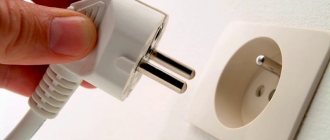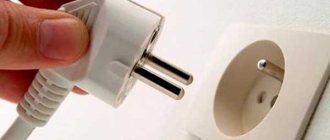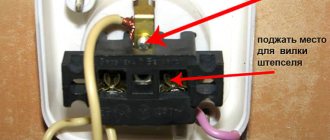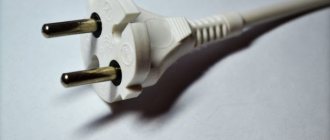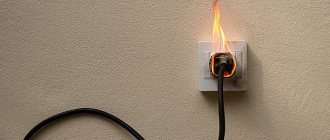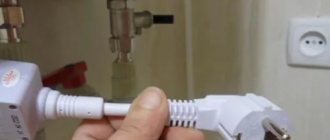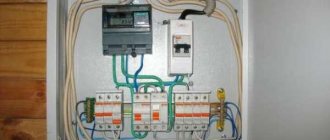To connect consumers to power, sockets designed for different power levels are used. Their use makes turning on and off household appliances convenient and safe. However, sometimes situations arise when the outlet sparks and then its use becomes potentially dangerous. In the best case, the socket will simply fail, and in a complex emergency situation, any negative consequences are possible, including a fire. To avoid such cases, you need to know the causes of malfunctions and how to eliminate them.
Where does the crackling sound come from in the socket?
The appearance of a crackling sound in an outlet is, in most cases, the result of a small short circuit, i.e. the appearance of an electric arc in contact. This can happen for various reasons, and here we can highlight the following situations:
- oxidation of contacts at the plug and socket;
- exceeding the rated current of the socket;
- wear of sockets and plugs;
- poor contact in the contact group;
- initial poor quality of the socket;
- mismatch between plug and socket standards;
- problems with wiring in the house.
Let's take a closer look at all these situations. And also why they are dangerous, and how they can be eliminated.
Expert opinion
Viktor Pavlovich Strebizh, lighting and electrical expert
Any questions ask me, I will help!
For orientation purposes, we present the relationship between the current ratings of the sockets and the maximum power that they can provide, 220 watts per ampere. If there is something you don’t understand, write to me!
Why is a sparking socket dangerous?
So that you fully understand the possible consequences of a sparking socket, it is worth saying that the resulting discharge is similar in nature to lightning or an electric arc when operating a welding machine . Of course, a breakdown in an outlet is usually not so destructive, but still.
The sparking of the outlet ultimately causes the surrounding elements to ignite and, as a result, a fire . Electric discharges themselves, the temperature of which can reach several thousand degrees Celsius, and simply heating of the socket conductors, which causes sparking, are to blame for this.
Also, in certain cases, sensitive electrical equipment and devices plugged into such an outlet may burn out.
In any case, if you notice that your outlet is sparking, you must immediately stop using it, and do not start without identifying and eliminating the cause of the problem.
The socket sparks. For what reasons? How to fix?
- Cleaning and freeing contacts from traces of oxidation and burns, if any. This applies to the contacts to which the plug is connected;
- Checking the quality of the connection of the power wire to the terminals of the contact group. If the clamp is bad, carbon deposits have appeared there or they have become too oxidized, then they should be cleaned;
- If the cause of the crackling sound is wear and tear on the wiring itself, you should stop using the outlet until the current-carrying cable is completely replaced;
- If you have installed a product of poor quality, or as a result of heating and constant sparking, the socket has received severe damage to the contacts or clamps with the contact group, then you should completely replace it with a new, good quality one, designed for the load that you expect for this power supply point.
Low quality
As I wrote earlier in my article “What You Shouldn’t Save on When Repairing,” electricians do not tolerate purchasing low-quality products. If you are not yet familiar with this material, you can read it at this link.
You can try to save your money on laminate, paint or drywall, but never on electrical fittings or wiring. Such savings will not only lead to possible breakdowns of other household appliances, but will also create a fire hazard in the home. A high-quality product will easily withstand the load indicated on it. Cheap options from unknown manufacturers can even be burned by a vacuum cleaner. It is best to purchase goods from trusted suppliers. I would recommend checking out the range and prices on Yandex Market.
Loosening screw terminals
If, when installing the internal mechanism of the socket with a screw clamp, the supply wire was not secured well enough, this can quickly lead to sparking and crackling in the socket. This is one of the worst possible failure scenarios, as the stress applied when you insert the plug begins to further destroy the already poor connection.
Such problems can cause the outlet to start sparking even when you are not using it. This is very dangerous from a fire point of view, because a short circuit can occur at any time. This is one of the most common causes of fire due to faulty electrical wiring.
Inconsistency of plug and socket standards
In Russia two standards are used:
- type “C” or “Europlug”
: plug with two round pins with a diameter of 4 mm. Soviet-style plugs, still in use today, had the same pin diameter. - type "F" or "Schuko"
: plug with 4.8 mm diameter pins and ground pin. It is mistakenly called a "Europlug", although this term is a translation of the word "europlug".
If the socket is designed for type “C” plugs, then connecting type “D” to it leads to loosening of the contacts and increasing the gaps between them. Further use of plug “C” leads to insufficient crimping of its contact blades and sparking. Using "C" with "D" sockets, especially when drawing high current, produces the same results, since the contact system is not designed to crimp smaller diameter pins. Although manufacturers are trying to make the contacts universal, realizing that a socket with a grounding contact will not always be used only for connecting Schuko plugs.
If the socket cracks during operation
If a cracking sound is heard when the plug is in the socket, then this is already a sign of poor contact in some part of the electrical circuit. Often, over time, the surface of the plug or the socket itself heats up, or even all at once.
What kind of lighting do you prefer?
Built-in Chandelier
Causes of crackling noise in a working outlet
In fact, a working socket makes noise for the same reason as when inserting a plug - the contacts do not touch closely, and in some places they do not reach each other. The consequences are standard: their surface oxidizes, resistance to electric current increases and the metals begin to heat up.
In the same way, a socket cracks if the bolted connections are loosened - the wire inside the contact begins to move and protrusions form, between which sparks appear. The socket begins to make noise, and if the contact is very bad, it can heat up and melt.
Also, the cause of sparking may be a mismatch in the diameter of the pins of the plug and the contacts of the socket; a typical example is when an old Soviet plug is inserted into a modern Euro socket.
Elimination methods
Selection of sockets, plugs and tees
The reason for the incorrect operation of the socket may also be the poor quality of both the socket itself and the plug of the electrical appliance; this problem is discussed in detail in the following video:
Why does the socket pop and click? What does this mean and what should be done?
This may be old wiring that has already lost its characteristics. It may have breaks and cracks in the cable. If this is observed at the junction of the wire contacts with the terminals of the clamps, then the wiring itself may be the cause of the appearance of crackling noises and sparks in the sockets.
Expert opinion
Viktor Pavlovich Strebizh, lighting and electrical expert
Any questions ask me, I will help!
This concerns largely the quality of the alloy that is used to make the contacts, as well as how the contacts themselves are made. If there is something you don’t understand, write to me!
Grounding the outlet: what is it used for?
Older houses often lack grounding. People who care about their future should be wary of the fact that there is no grounding. The function of grounding is to reduce the consequences of electric shock to non-life threatening, in other words, it is a protective function. Let's look at an example of how grounding works. When the insulation of the phase wire inside any electrical appliance is worn out or damaged, then the body of the device, upon contact with the exposed section of the core, is under voltage equal to the phase voltage - 220 V. Human contact with such a device will result in electric shock, which can even be fatal. If the device body is grounded, then the voltage on it during an insulation breakdown will be close to zero. And contact with the unit will not pose a danger.
Methods for grounding a socket
There are several ways to ground a socket:
- connecting a protective contact to an active PE conductor of the wiring line; This is the simplest method of grounding, since it implies the presence of a ground line in the wiring. You just need to connect the yellow-green wire to the protective contact.
- additional laying of PE wire. When the apartment does not have a grounding line, inspect the panel on the landing. If it has a grounding bus, everything works out well for you, because there is connectivity. If there is no grounding on the shield, you can connect to a lightning rod on the roof, since these devices are always grounded. When there is no lightning rod, the solution to the problem is to install a grounding loop of one of the configurations. The most common of them is the triangle. For private houses this operation is easily feasible, for the first floors of apartment buildings - depending on the situation. On the north side of the building, at a distance of 1 m from the wall, an equilateral triangle with sides of at least 1.5 m is marked on the ground. A trench 0.5 m deep is made along the perimeter of the triangle, and pieces of steel angle 50x50 mm with a length of at least 2 m are driven into its vertices. until buried below ground level. Then the ends of the pins are welded together with a steel strip, which is extended to the wall of the house, and then a PE cable is attached to it and brought inside the room.
First reason. The plug is faulty.
The first reason for heating the outlet may not be a malfunction of the outlet itself, but... a malfunction of the plug. The fact is that if the contact inside the plug deteriorates and it begins to heat up, the heat will be transferred to the body of the socket and its contacts. Visually, it may seem that it is the outlet that is heating up, although the reason is the plug.
The solution here is simple! Insert the plug into another outlet (preferably in another room) that has not had any problems until now. Turn on the appliance that is powered by this plug.
Wait 5-10 minutes. Remove the plug from the socket and touch the contacts of the plug. If they are hot, then the problem is in the plug; if they are cold, it is in the socket.
In addition, power some powerful device from the first (suspicious) outlet. For example a heater. Wait 5 minutes and feel the plug contacts. Heating will indicate a faulty socket, because... The default plug is OK.
The socket sparks - why this happens and how to fix it
Worn socket connectors.
If the plug is frequently inserted and pulled out of the socket, the clamping jaws may weaken and their strength will not be enough to compress the electrodes; they will dangle. As a result, the contact will weaken and heating will occur. If you notice this in time, then such an outlet can be saved (how to fix an outlet). In this case, it needs to be disassembled and inspected for melting and damage, after which the jaws must be tightened with pliers for tighter contact.
As a result
All household electrical wiring is designed with a multiple safety margin, so if a socket sparks, a plug or extension cord gets hot, then this is a signal to quickly find and correct the problem.
The problem may not be found right away - this most often indicates that a device whose power is higher than the wiring can handle is plugged into the outlet. In this case, you need to look for a “weaker” device or make an additional socket.
It will be useful for everyone to know why an outlet sparks. Why an outlet sparks will be useful for everyone to know, since this is abnormal and can cause: breakdown of expensive equipment, fire, or injury to a person. Next, we will find out the main reasons for the failure of the outlet and tell you what to do to prevent this problem from happening again.
Consequences of sparking
If measures are not taken in time to eliminate sparking in an electrical outlet, the consequences can be serious. First, the plastic case begins to melt, and the contacts gradually burn. If you try to pull out the plug, the plastic may become exposed to electric current. Sometimes a small spark is enough to start a fire that can quickly engulf the entire house. Therefore, you need to know what to do if the socket sparks when you insert a plug.
Even if automatic switches are installed in an apartment or house, this does not provide a complete guarantee that a fire will not occur. It happens that their performance is not checked for years. Turning on powerful devices can cause a network overload, due to which the wiring will catch fire and the machine will become faulty.
How to avoid problems?
Above we have provided the main reasons why the socket sparks when the plug is turned on. Now we’ll talk about how to avoid these problems, and in other words, about preventive measures.
- Timely revision of electrical wiring with visual inspection of all important elements.
- Turn electrical appliances on and off using the button on the device body, that is, insert and remove the plug into the socket when the device is turned off.
- Install a circuit breaker on the line of socket groups that corresponds in current parameters to the capabilities of the laid electrical wire.
- In wet areas, use only waterproof sockets.
Why the socket sparks: reasons and solutions
The contacts in the socket often begin to crack if they are worn out. As a rule, this happens the moment you insert the plug into the outlet.
Expert opinion
Viktor Pavlovich Strebizh, lighting and electrical expert
Any questions ask me, I will help!
That’s why, if your home has power points that will be intensively used, you need to install high-quality sockets, plus look at what rated load they are designed for. If there is something you don’t understand, write to me!
Disadvantages of electrical wiring
The daisy chain connection of sockets brings many problems for consumers. This is when the cable from the panel or junction box goes to one outlet, from it to the next, and so on. The cable cores are connected under one screw. With this scheme, the total current of all electrical appliances connected to the loop flows through the first contact connection. But the connection itself is also designed for the rated current of the outlet. This is why even under a light load the plug in the socket sparks and melts: it is heated by the currents of electrical appliances connected to neighboring sockets. You can eliminate the loop by redoing the electrical wiring. All wire connections must be made in junction boxes, with a personal cable laid to each outlet. Perhaps these are all the reasons why sometimes the socket sparks when you insert a plug into it. Knowing the answer to this question will allow you to protect yourself from such an unpleasant and dangerous effect.
Crackling noise when plugged in
This phenomenon is observed quite often - for example, if you leave home for several days and unplug electrical appliances from the outlets. Upon returning, everything turns back on and then a noticeable flash is visible in some sockets and a loud crack is heard.
Causes
Despite the fact that this all looks quite threatening and causes many to reflexively pull their hands away from the sockets, there is nothing in this phenomenon that indicates a malfunction. It’s just that when the contacts of the plug approach the contacts of the socket, an electric arc jumps between them an instant before contact. This is the nature of electric current and the higher the voltage at the contacts, the greater the distance such an arc can stretch.
In industrial conditions, special arc-extinguishing chambers are made near the contacts of starting devices, and in particularly powerful devices, devices are even used to extinguish the arc with compressed air or another method.
What’s interesting is that reflexively withdrawing your hand from such an outlet is completely meaningless. And not because this phenomenon is not dangerous, but because of deception of vision and hearing due to the imperfection of these sense organs. The fact is that the microlightning that occurs when contacts touch lasts a hundredth, if not a thousandth, of a second. Given that the human eye perceives everything at a speed of 24 frames per second, it only sees the original image captured on the retina and gradually fades away. It’s the same with sound - an audible crack is thunder in miniature - first the primary disturbances of the air reach the ear, and then the consequences of displacements of its molecules.
What can be done
It would seem that the issue has been resolved and now you can simply not be afraid of this phenomenon, if not for one “but” - not every socket sparks... This is even more surprising if all the installed sockets are the same, which means that this behavior cannot be explained by differences in design.
The reason is simple - plugs from switched-off devices are inserted into some sockets, and plugs from switched-on devices are inserted into others, on the contrary. Take a computer for example - usually all its peripherals are connected to one surge protector with 5-6 outlets. This is the system unit itself, a monitor (or even two), speakers, a printer, a router - maybe something else is connected. When the computer is turned off, in fact, it is not completely de-energized - all its components are in standby mode, so if you unplug the surge protector from the socket, it will “remember” its last state. Accordingly, when the plug is inserted into the socket again, all devices will simultaneously “fucking” the electric current, which will cause a discharge in the socket.
This will not happen if, before leaving, you turn off the power to each device separately - manually turn off the monitors, turn the switch on the power supply of the system unit, flip the toggle switch on the speakers and the printer. Then, when the plug is plugged into the socket, the circuit will not close and there will be no discharge.
How does this affect the outlet?
Theoretically, when even microlightning occurs, the surface of the contacts burns and may become unusable over time - the resulting soot will cover everything with a film with high resistance, this place will begin to heat up and the socket may begin to melt.
In practice, the discharge hits the tip of the plug and the very beginning of the socket contact - when the plug is fully inserted, the working surface of the contacts is completely different. Moreover, if the plug is not taken out of the socket often, then the contact is very far from being damaged.
As a result, when the socket sparks when you turn on the plug, you need to realize that everything has already happened and simply insert the plug further.
Loose contact connections
The same effect occurs if it is not the connector contact that loosens, but the wire connection. They may not be tightened enough initially, so they will loosen over time, and an area with transient resistance will appear on them. The further process is similar to that described above, with the only difference being that it takes a longer time. It is believed that contacts need to be tightened periodically. But practice shows that with initially high-quality tightening of copper conductors, they will never need to be pulled. But aluminum wires need to be tightened, since they are softer and tend to gradually deform under the action of the mounting screws. Another property of aluminum affects the heating of contacts: when bent, the wire breaks. An inexperienced electrician may not notice this; the wire looks intact, but in some place it is enough to bend it a little for it to break completely. Heating also begins at this point and is transferred to nearby metal parts. As a result, the wire sparks and burns out. That is why the installation of new electrical wiring in residential premises using cables with aluminum conductors is now prohibited.
What a malfunction can lead to
The breakdown of any electrical device can lead to negative consequences for both buildings and human health.
The most likely scenarios for this development are:
- A fire occurs in the premises.
- Failure of devices connected to the electrical network.
- Damage to wires and cables that supply voltage to a specific device.
- Electric shock to people using a faulty device.
Everyone should know how to identify a malfunction and how to fix it. Even an ordinary user who does not have special knowledge and skills can prevent such malfunctions.
Question for electricians
In the bathroom, with the boiler on, the entrance to 16a was turned off. I checked the socket - everything is in order. The boiler is in another socket - it works. I connected the boiler to an old outlet via an extension cord, the machine does not turn off. Please advise what's wrong. (the boiler had previously worked for 3 years without problems)
When checking the boiler, you should insert the plug into an identical socket (i.e. with grounding contacts). Try connecting another equipment with grounding to the outlet feeding the boiler. If it turns off, it’s a problem with the socket and/or line. The extension cord must also have a grounding wire and contacts in the sockets. But it smells like an insulation breakdown in one of the heaters (try clicking the buttons on different heaters one by one) or wires in the boiler itself.
What to do to avoid breakdown
You can prevent a malfunction by fulfilling the following conditions:
- When using a switching connection in the form of a plug connector, use the same type of connection elements; use the socket only for its intended purpose and in accordance with the operating rules.
- If the product is made of poor quality materials, it must be replaced.
- Use tested devices that have certificates of conformity. Purchase in specialized stores, not in markets.
- If the electrical strength of the insulation of wires and cables is low, replace them with new ones that meet the requirements for electrical wiring. The need for replacement is determined during preventive tests or when emergency situations occur in electrical networks.
- If the screw connection of the wires with the contacts is loosened, they must be tightened. When using clamps (spring mechanism) in a specific model, the correct solution is to replace the product with a new one equipped with screw clamps.
The socket doesn't work: where to start?
If the outlet in the apartment does not work in a house or apartment, it is worth checking this fact, and only then taking more serious measures.
First, try connecting other household appliances. Make sure it doesn't work either. Immediately after this, plug the device into another outlet for a control test. If you have a multimeter, measure the voltage in the network.
To carry out repair work in the apartment, prepare the following tools:
- voltage indicator or indicator screwdriver to determine the phase;
- pliers with a dielectric handle (alternatively, you can take regular pliers and wrap the handles in several layers of electrical tape);
- a screwdriver with a Phillips and a regular blade;
- sharp knife (stationery or construction knife);
- new wire or circuit breaker (may be required depending on the circumstances).
In some cases, a chisel and a hammer are necessary if you need to widen the hole for the socket or perform other work. It is also worth preparing a multimeter to check the sockets in the apartment. If you don't have one, use a table lamp (make sure it works right away).
Why can a socket light up even if nothing is plugged into it?
A house fire is scary. Most often, the cause of fire is careless handling of fire, but electricity also accounts for a huge number of incidents.
Unfortunately, even following the rules for working with electrical appliances cannot protect your home from an electrical outlet catching fire. It can catch fire even if nothing is included in it. The article explains in detail why this happens and how to minimize the risks.
Main causes of fires
As simply as possible, a socket can be represented as two wires (contacts) placed in a plastic box and not interacting with each other in any way. When, for example, a plug is inserted into it, the metal connects both wires and current begins to flow into the electrical appliance. If the wires are not connected by anything, fire is impossible.
Indirect connection
The most common cause of fire is a transit or end-to-end connection. It is absolutely ideal when separate wiring is laid to each socket from the distribution box. Very often, in order to save money, only one is connected directly to the box, and this is very dangerous.
For example: there are 4 sockets in a room, one of which is transit, and the remaining three are powered from it. If you insert 6 electrical appliances into such a network, 2 in each socket except the main one, all 6 devices will be powered from it. An overload will occur, the contacts of the main socket will begin to heat up, the plastic will melt and, as a result, the wallpaper may catch fire, followed by the whole house.
A pass-through connection can be even more dangerous, as in some older homes the same outlet may be connected to two different apartments. Even if one of the neighbors does not use it, the other can connect an air conditioner, refrigerator and TV through an extension cord.
If a fire breaks out, it is highly likely that it will spread to both apartments. Fortunately, both backhaul and end-to-end connections are not used at the same time, so this development is unlikely.
Accident: insect or foreign object
Cases where an insect shorted contacts, died and caused a fire are quite rare, but there are stories from victims online.
Another reason is the ingress of any object that can close the contacts. There are known cases when a child played electrician during a preventative power outage, and this became known only after it was turned on.
How to avoid fire?
First, you need to consult a specialist. He must determine which sockets use a direct connection, and which use a through and transit connection. This is enough to avoid overloading the network with electrical appliances and eliminating the main cause of the fire.
Precautionary rules and tool kit
The electricity needs to be turned off. You need to unscrew the plugs or block the machines on the dashboard. Work is carried out using special gloves. They are called dielectric. Gloves are made of latex or rubber and prevent current from entering the skin.
Residents must be warned about the work being carried out. Otherwise, someone might turn on the electricity.
Tools to repair the socket will require:
- straight screwdriver
- crosshead screwdriver
- pliers
- wire cutters
- multimeter
- insulating tape
- cable cutter
It is important that the handles of the tools are securely insulated. Sometimes a file and sandpaper are also required
It’s worth stocking up on them just in case.
The socket is shorting what to do
- Inconsistency in the standards of the main elements of the contact connector, that is, sockets and plugs.
- Connecting several powerful electrical appliances through an extension cord or tee, which leads to an electrical overload.
- Worn connectors caused by various reasons.
- Loosening of contact clamps.
- Poor quality electrical installation products, in this case sockets.
Useful tips Connection diagrams Principles of operation of devices Main concepts Meters from Energomer Precautions Incandescent lamps Video instructions for the master Testing with a multimeter
Connecting enabled devices
This point will be valid regardless of the manufacturer. If the permissible power is exceeded by the sum of the powers of all connected devices and consumers, both the plug and the good quality socket will begin to heat up. The chance of a spark greatly increases, and the situation can develop into a fire hazard.
Connecting enabled devices.
If you connect above the rated power to sockets of poor quality, they will fail very quickly. In general, electrical installation products are not designed for loads higher than the values set by the manufacturer. It is also dangerous for wiring inside walls and inside the house.
Overcurrent
Excessive current load can cause sparks to appear in the outlet. All sockets are designed for a certain threshold current in the network. Good quality products for larger ones, bad ones for smaller ones. Moreover, it is very important here how long the outlet will be able to withstand the maximum load close to the nominal value.
Overcurrent.
If you plan to connect many appliances or devices to one outlet, then buy one of good quality. There are many well-known companies that produce quality products. Such products are able to withstand loads near the maximum for a long time, without the consequences of failure in the future.
